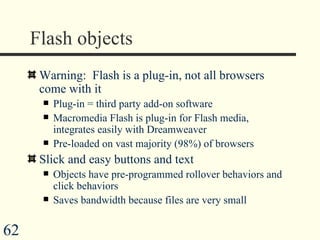

- MACROMEDIA DREAMWEAVER 8 USING FTP SOFTWARE
- MACROMEDIA DREAMWEAVER 8 USING FTP CODE
In the long term, you will find it helpful to use a Dreamweaver template so that you can store elements (i.e. It is not necessary to put an anchor at the top of a document, as linking to the document’s own file name e.g. A link to an anchor has a # before the anchor. There must be no spaces or uppercase letters in anchor names. If you want to put an anchor in a file, go to the Insert menu, click Named Anchor and give it a name. Note: The “Anchors” link goes to a place (an “anchor”) in an HTML file, not to the top of the file. Reload the page in the browser by navigating to it and pressing F5.Open the file whose links are not working in Dreamweaver.You should now be able to see index.htm and more.htm in your browser at: Again, use your UCL User ID and e-mail password.
Go to Start | Programs | Software P-R and click Publish Web Pages. The UCL server requires an additional step not normally necessary on other servers: Highlight more.htm and click the same icon. Do not include dependent files, if prompted to. Highlight the file index.htm and click the blue up-arrow Put File(s) icon. Click the Refresh icon (circular arrow, second icon from the left). In the Files pane (on the right, go to the Window menu and click Files if it is not there), make sure the drop-down box at the top of the Site pane says Local (NOT Remote) View. Close index.htm by going to Close on the File menu. Note: You can use similar techniques to link to any type of file - including PDFs, Word documents, images and sound files (.wav or. Highlight your name and in the Link box, type: mailto: followed immediately by your. Highlight Anchors and in the Link box, type:. Highlight ISD and in the Link box, type:. Highlight Google! and in the Link box, type:. Otherwise the visitor to your site would have to click the Back button to return to your site. Note: In the case of the following links to other sites, you should select _blank in the Target box (to the right of the Link box), so that the other site opens in its own window. Double-click index.htm in the right column to open it, highlight Images etc. Close the file by going to Close on the File menu. Highlight Return to homepage and in the Link box in the Properties pane, type index.htm. Still in more.htm, type the following line:. Tip: Keep file and folder names simple - only use 0-9, lower case a-z and hyphen. Also create a Heading 1 with the text Images. Create a new file by going to the File menu and clicking New. 
Note: It is good to use plenty of headings and lists to make your pages easy to understand, and accessible to disabled users.
Save the file by going to Close on the File menu or pressing Ctrl+W. You should now have a line across the page. Click above Resources and go to HTML | Horizontal Rule on the Insert menu. Highlight Google!, IS and Anchors, and click the icon in the Properties pane with the three squares and the three lines. Tip: Do not use underline in HTML files, otherwise your users will think it's a link! Highlight your surname and click the B icon in the Properties pane. 
Note: If a change is made in Code view you need to click in Design view before it takes effect. Go to Design on the View menu to return to the original view. You can drag the line between the views up and down, and edit the page in either view. This view is useful for trouble-shooting. Go to the View menu and select Code and Design.Make sure that it is saving in the n:\website folder. Save the file as index.htm by going to Save on the File menu.This is what appears in the browser’s Title Bar and, if the page is bookmarked, it will appear on the Bookmarks or Favorites menu in the browser. In the Title row (at the top of Dreamweaver), replace Untitled Document with Homepage of.Make sure that Basic Page in the left pane and HTML in the middle pane are selected. Create an empty file, if there is not already one open, by going to File | New.







 0 kommentar(er)
0 kommentar(er)
